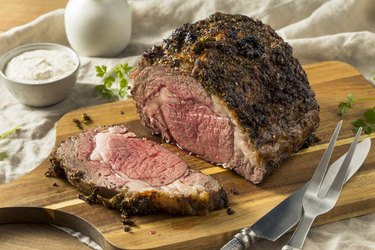
Prime rib is a cut of beef that makes for a flavorful and impressive main dish — that's why it's especially popular during the holidays and special occasions.
According to the USDA, prime rib is also known as a standing rib roast. It is cut from the prime rib location and usually includes six ribs. (The name isn't to be confused with the USDA Prime quality grade.) And if you've ever eaten a ribeye steak, you've eaten prime rib — the only difference is that it has been sliced into steaks before being cooked. A ribeye filet is a ribeye steak with the cap removed.
Video of the Day
Video of the Day
Many recipes call for prime rib roast to be roasted in the oven for several hours, though cooking it in a pressure cooker (like an Instant Pot) can save you some time. Prime rib is usually cooked via dry methods, but using a pressure cooker traps moisture from the hot steam.
Making prime rib in a pressure cooker is a good idea because the rib meat isn't naturally as tender as other cuts of beef. The steam created from the high pressure helps to break down the fibers in the meat to tenderize it and make it taste as though it's been cooking for much longer.
Try this tasty pressure cooker prime rib recipe from Shane Hughes, head chef at The Toll Bridge Restaurant & Bar in the U.K.
Things You'll Need
Large pressure cooker
Prime rib roast
Olive oil
Brown sugar
Dry red wine
Onion
Carrots
Celery
Bay leaf (optional)
Thyme (optional)
Large frying pan
Red wine vinegar
Metal skewer
Fine mesh strainer
Saucepan
Step 1: Let the Meat Come to Room Temperature
Take the roast out of the fridge and let it reach room temperature, about 1 hour. Cooking it from cold will take more time.
Step 2: Prep a Mirepoix
A classic mirepoix forms the base of many recipes. According to the National Onion Association, a French mirepoix contains a mixture of onions, carrots and celery — the onions and celery enhance the aroma of a dish while the carrots add an element of sweetness.
A ratio of two parts onion, one part carrots and one part celery is recommended.
Hughes also recommends adding herbs like bay leaf and thyme. Chop the vegetables into thick pieces so they don't dissolve while under pressure.
Step 3: Sear the Prime Rib Roast
Add plenty of olive oil to a frying pan and get it very hot. Sear all sides of the rib thoroughly for a few minutes each to seal in the juices.
Step 4: Sauté the Vegetables
A mirepoix is traditionally sautéed so the vegetables are browned. Here's how to do it:
- In the same frying pan with the remaining olive oil, sauté the vegetables until they are golden brown.
- Add a splash of dry red wine to the pan with the vegetables (a process known as deglazing).
- Add 1 tablespoon of brown sugar and a dash of red wine vinegar.
- Let the vegetables cook until the liquid has reduced to about a quarter of its amount.
Step 5: Cook It
Transfer the vegetables and rib roast to a large pressure cooker. Lock the lid to ensure the steam doesn't escape as the cooker comes to pressure.
Cook the prime rib roast at the lowest setting for 2 1/2 hours. More or less time may be necessary depending on the size of the roast.
Step 6: Test to See if Meat Is Done
After 2 1/2 hours, allow the pressure cooker to come down from pressure to safely unlock and open the lid. To check if the meat is done cooking, pierce the roast with a metal skewer. The roast is cooked through when there is no resistance to removing the skewer.
Step 7: Allow the Roast to Cool
Before removing the roast from the pressure cooker, allow it to cool. Keep the lid on the pressure so steam doesn't escape and take some of the flavors with it. Allow the roast to cool for at least 15 minutes.
Step 8: Remove the Roast
When the roast is cool, remove it from the pressure cooker. Pass the cooking juice through a fine mesh strainer to separate the vegetable pieces.
Step 9: Reduce the Cooking Liquid
In the frying pan you used earlier, reduce the cooking juice by simmering it on low heat until it thickens.
Step 10: Slice, Reheat and Serve
When you're ready to serve the roast, slice it. If needed, reheat the roast in a warm oven but keep an eye on it so it doesn't dry out. Serve the roast with the garnish of your choice and top it with the reduced cooking liquid to add moisture.
- U.S. Department of Agriculture: "Stand Up Your Holiday Feast with a Tasty Rib Roast"
- Texas Department of Insurance: "Pressure Cookers/Steamers Safety"
- U.S. Department of Agriculture FoodData Central: "Beef, Rib, Small End (Ribs 10-12), Separable Lean and Fat, Trimmed to 1/8'' Fat, Prime, Raw"
- American Heart Association: "Picking Healthy Proteins"
- National Onion Association: “The French Mirepoix”